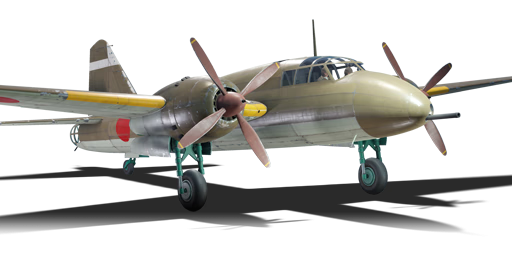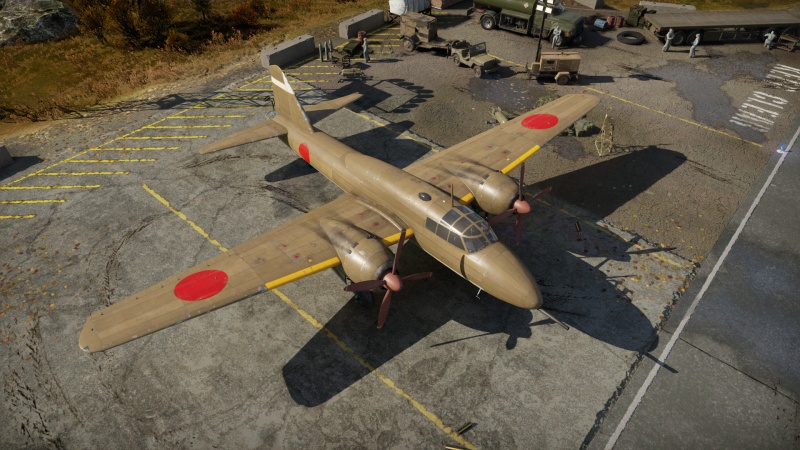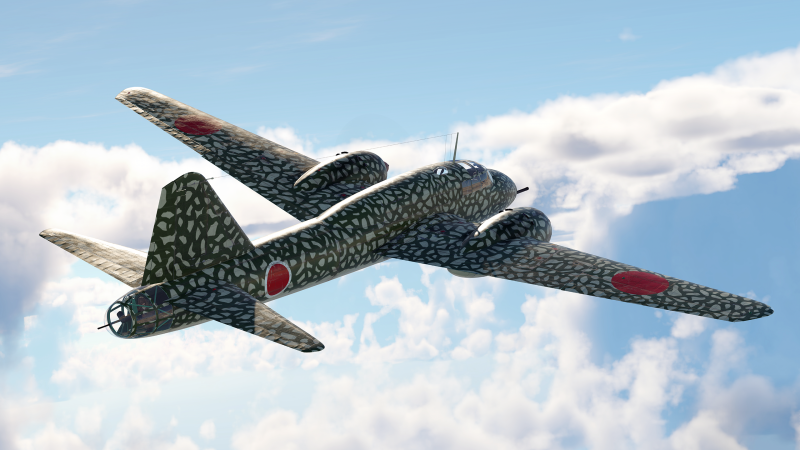Difference between revisions of "Ki-109"
m (Preemptively Linking Art) |
Colok76286 (talk | contribs) (→Media: Added Shooting Range episode) |
||
| Line 152: | Line 152: | ||
;Skins | ;Skins | ||
* [https://live.warthunder.com/feed/camouflages/?vehicle=ki_109 Skins and camouflages for the {{PAGENAME}} from live.warthunder.com.] | * [https://live.warthunder.com/feed/camouflages/?vehicle=ki_109 Skins and camouflages for the {{PAGENAME}} from live.warthunder.com.] | ||
| + | |||
| + | ;Videos | ||
| + | {{Youtube-gallery|GSSJKUqU3WE|'''The Shooting Range #266''' - ''Challenge'' section at 09:58 discusses the {{PAGENAME}}.}} | ||
== See also == | == See also == | ||
Revision as of 08:37, 13 September 2021
Contents
Description
The Ki-109 is a rank I Japanese strike aircraft with a battle rating of 1.7 (AB), 2.0 (RB), and 2.3 (SB). It was introduced in Update 1.71 "New E.R.A.".
Based on the Mitsubishi Ki-67 heavy bomber, the Ki-109 was designed as an interceptor in an attempt to counter the American bombing raids that devastated Japan. It is armed with a 75 mm anti-aircraft gun modified for aircraft use, and almost all defensive armament from the bomber version has been stripped, except for the tail turret, in order to maximise performance.
In-game, the Ki-109 functions much as it was intended to in reality. The 75 mm gun is effective against bombers, but struggles to hit small agile targets such as fighters. Its own defensive armament is very poor, and it should avoid combat with fighters at all costs. Alternatively, the 75 mm gun is also effective against tanks if a clean hit can be obtained.
General info
Flight performance
| Characteristics | Max Speed (km/h at 6,050 m) |
Max altitude (metres) |
Turn time (seconds) |
Rate of climb (metres/second) |
Take-off run (metres) | |||
|---|---|---|---|---|---|---|---|---|
| AB | RB | AB | RB | AB | RB | |||
| Stock | 531 | 515 | 9300 | 21.0 | 21.8 | 8.3 | 8.3 | 650 |
| Upgraded | 570 | 550 | 19.1 | 20.0 | 14.0 | 10.9 | ||
Details
| Features | ||||
|---|---|---|---|---|
| Combat flaps | Take-off flaps | Landing flaps | Air brakes | Arrestor gear |
| ✓ | ✓ | ✓ | X | X |
| Limits | ||||||
|---|---|---|---|---|---|---|
| Wings (km/h) | Gear (km/h) | Flaps (km/h) | Max Static G | |||
| Combat | Take-off | Landing | + | - | ||
| 650 | 300 | 428 | 399 | 250 | ~5 | ~1 |
| Optimal velocities (km/h) | |||
|---|---|---|---|
| Ailerons | Rudder | Elevators | Radiator |
| < 360 | < 360 | < 360 | > 313 |
Survivability and armour
The fuselage durability is strong enough to shrug off machine gun fire and some cannon rounds. To add to the plane's defense, there is a rear machine gunner which can protect the plane's tail. While so, its defensive armament can be under-performing and is likely to lose the defensive gunner before an enemy plane can be damaged as there is no protective glass for him. In fact, the Ki-109 doesn't have any armour except on the bottom of the gun itself, which is quite meaningless for the overall plane. Due to this, head-on attacks are strongly unadvised. Use the aircraft's manoeuvrability to evade incoming enemies in front of the plane. The Ki-109 is equipped with self-sealing tanks, meaning it can survive one of its wings being set alight and continue to accomplish its tasks. Though, it is advised to retreat to base if that happens.
Modifications and economy
Armaments
Offensive armament
The Ki-109 is armed with:
- 1 x 75 mm Type 88 cannon, nose-mounted (15 rpg)
Defensive armament
The Ki-109 is defended by:
- 1 x 12.7 mm Ho-104 machine gun, dorsal turret (500 rpg)
Usage in battles
The Ki-109 isn't only about using the gun to attack ground targets, its also about intercepting enemies and returning safe and sound. While designed as an interceptor, the climbing rate is inadequate for this role when in stock condition. Sideclimbing is a mandatory rule one should obey to. Despite its size, which resembles a medium bomber, the Ki-109 is surprisingly manoeuvrable. Comparable to all twin-engined heavy fighters and on par with Germany's Fw 190 series. Still, it's better not to use those blessings for dog-fighting a fighter: use the Ki-109's manoeuvrability to evade the enemy bomber's defensive gunners if the first pass of a bomber interception fails. Another way to use the manoeuvrability is to outmanoeuvre inexperienced pilots in a heavy bomber who try to evade the first shot by making a turn like a single-engine fighter for another pass. Or, in ground attack at low altitude, the Ki-109 can regain its position quickly for another pass on enemy tanks below.
Boasting a 75 mm Type 88 cannon, the gun is quite versatile in taking down both air and ground targets. This, however, is not without drawbacks: 15 rounds of ammo total, combined with very low rate of fire and relatively low bullet velocity, means every shot counts since there are no other offensive weapons on the Ki-109. It is advised to seek assistance from teammates to hunt down bombers. The recoil of the gun itself is another issue to consider, so in order to minimise inaccurate shots, try to shoot the target during a shallow dive. One thing to note: unlike other armour-piercing rounds that contains no more than 90 g of TNT, the armour-piercing rounds used in the Type 88 is filled with 460 g of TNT. This is overkill in taking down even the biggest heavy bombers like Pe-8. Therefore, it is advisable to use AP-T ammo for every battle due its filling, as the HEFI-T just has 30 more g of TNT.
Manual Engine Control
| MEC elements | ||||||
|---|---|---|---|---|---|---|
| Mixer | Pitch | Radiator | Supercharger | Turbocharger | ||
| Oil | Water | Type | ||||
| Controllable | Controllable Not auto controlled |
Not controllable Not auto controlled |
Controllable Not auto controlled |
Combined | Controllable 2 gears |
Not controllable |
Pros and cons
Pros:
- Powerful 75 mm gun, effective against both bombers and tanks
- Relatively good performance and agility for its size
- Self-sealing fuel tanks
Cons:
- No forward-firing armament besides the 75 mm gun
- Very low rate of fire for the main gun and low ammunition capacity
- Extremely weak defensive armament
- No armour besides the 75 mm gun cradle
History
In 1943, the decision was made to develop a new heavy fighter/interceptor based on the existing Ki-67 bomber. The new design was part of Japanese efforts to counter strategic high-altitude bombing conducted by heavy US bombers, such as the B-29 Superfortress, on the Japanese home islands. To achieve this, Mitsubishi engineers proposed the installation of the 75mm Type 88 anti-aircraft cannon inside the aircraft's nose. The project, designated as Ki-109, was approved in early 1944 and the first two prototypes were already completed in late summer of the same year.
However, as initial testing showed that the aircraft was lacking speed due to its high mass, measures were taken to remove unnecessary equipment in order to save on weight. During this process, the Ki-109 lost most of its defensive turrets and only retained the one located in the tail section. Another attempt to improve the aircraft's speed was the intended installation of the new, more powerful Ha-104ru engines in the following production batch, however this idea was quickly dropped due to the engine having reliability issues, thus production continued with the standard Ha-104 engines.
In March of 1945, 22 Ki-109s were delivered to the 107th Sentai unit, which was tasked with protecting the strategically important cities of Tokyo and Yokohama from air raids. In July, only a few months before the war came to a close, the 107th Sentai was formally disbanded, leaving behind some Ki-109s to be tested for effectiveness against ships, this also marking the end of the aircraft's operational service.
Media
- Skins
- Videos
See also
External links
- [Devblog] Mitsubishi Ki-109: "An Unexpected Threat"
- Official data sheet - more details about the performance
| Mitsubishi Company (三菱商会) | |
|---|---|
| Fighters | A5M4 · Hagiri's A5M4 |
| A6M2 mod. 11 · A6M2 · A6M3 · A6M3 mod. 22 · A6M3 mod. 22Ko · A6M5 · A6M5 Ko · A6M5 otsu · A6M5 Hei · A6M6c | |
| A7M1 (NK9H) · A7M2 | |
| J2M2 · J2M3 · J2M4 Kai · J2M5 · J2M5 (30 mm) | |
| Hydroplanes | F1M2 |
| Interceptors | Ki-83 · Ki-109 |
| Bombers | G4M1 |
| Ki-21-Ia · Ki-21-I hei · Ki-67-I Ko · Ki-67-I otsu | |
| Jet Fighters | Ki-200 |
| Captured | ▃A6M2 · ␗A6M2 |
| See also | Mitsubishi Heavy Industries, Ltd. (Post-War) |
| Japan twin-engine fighters and strike aircraft | |
|---|---|
| Navy | |
| Land-based Fighter | |
| J1N | J1N1 |
| J5N | J5N1 |
| Army | |
| Ki-45 | Ki-45 ko · Ki-45 otsu · Ki-45 hei · Ki-45 tei |
| Ki-83 | Ki-83 |
| Ki-96 | Ki-96 |
| Ki-102 | Ki-102 otsu |
| Ki-108 | Ki-108 Kai |
| Ki-109 | Ki-109 |






